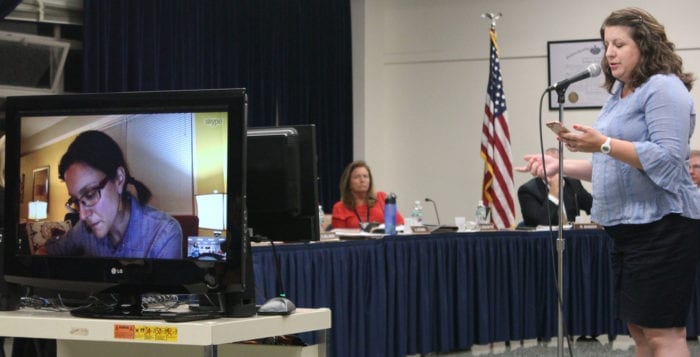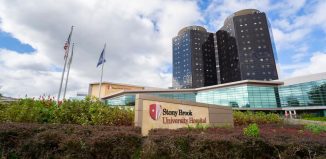Northport parents call for in-depth K-wing study

The Northport-East Northport board of education called on a specialist last week in an attempt to clear the air with concerned parents over potential health risks from gas fumes detected at Northport Middle School last spring.
At the Sept. 28 meeting, Dr. Lauren Zajac of Mount Sinai Hospital, a pediatrician specially trained in environmental health, fielded questions by the board and residents and encouraged the district to implement an indoor air quality program in all its schools.
“As a pediatrician and a mom myself, I would want to make sure our schools have good air because nobody is doing that right now — let’s become a leader in the state when it comes to indoor air quality,” Zajac said over a Skype call in the cafeteria at William J. Brosnan School.
“I hope we don’t hear 10, 20 or 30 years down the road students are developing illnesses. No level of unnecessary exposure to these chemicals is at all acceptable … ignorance to this is no excuse.”
— Denise Schwartz
She assured the agitated residents in the room that moving forward is the best plan of action.
“We can’t change what happened in the past and I’m sorry it happened, and I know it’s stressful,” Zajac said. “I recommend channeling this passion and energy into making sure a really good program is put in place.”
The board assured Zajac and residents it has begun the process of implementing a Tools for Schools program, which shows school districts how to carry out a practical plan to resolve indoor air problems such as volatile organic compounds and mold “at little to no cost using straightforward activities and in-house staff,” according to the U.S. Environmental Protection Agency website.
“Today we had a kickoff meeting for that program,” Northport Superintendent Robert Banzer said. “Tools for Schools is comprehensive and deals with anything having to do with air quality.”
Zajac’s appearance before the board followed consistent urging from the community for a longitudinal study of the school district to get to the bottom of four chemicals commonly found in perfumes and latex paints found in high concentrations in classrooms 74 and 75 in the K-wing corridor April 24. After an earth science teacher smelled fumes in the classroom, an investigation found the source to be a petroleum-based warehouse beneath the K-wing.
That discovery six months ago led to the closure of those rooms for the remainder of the school year. It remains off limits today.
The materials were removed and a series of air quality tests have since been conducted, one by a company called EnviroScience Inc. three days after the odor was first found. A second air quality test was performed by J.C. Broderick & Associates Inc. July 22.
Although the tests came up with “nothing that sounded the alarms from a health perspective,” according to Zajac whose team analyzed the data reports, parents have long feared for their children’s health in connection to the fumes.
Zajac pushed for the school and community to forego the longitudinal study as it may not provide the answers everyone is looking for. There are many unknown factors surrounding the possible exposures, and chemical levels in general are apt to change with each day, according to the specialist, resulting in an unreliable study.
“I think I’m going to explode if I hear ‘move forward’ one more time. You have to look back, you have to protect the children and staff that were there.”
— East Northport resident
“It would be very hard to draw conclusions as to whether a student’s visit to the nurse has anything to do with exposure concerns or unrelated illnesses,” she said, steering the conversation back to the future. “It could be done, but it would have so many limitations and I wouldn’t want it to take away effort from the most important thing — reducing the exposures from here on out.”
But some residents in the room weren’t as willing to let go of past problems within the school.
East Northport parent Denise Schwartz, whose three children have gone through the middle school, said she recently uncovered old newspaper articles documenting the school’s history of being a “sick building.” Mold, fungus and gas leading to headaches and fevers is not a recent problem here, Schwartz told Zajac.
“Every time it has come up, there has been some clean up that appeased people and then we move forward,” Schwartz said, implying negligence and incompetence by those in the school district. “I hope we don’t hear 10, 20 or 30 years down the road students are developing illnesses. No level of unnecessary exposure to these chemicals is at all acceptable … ignorance to this is no excuse.”
Mary Gilmore, a mother of two students whose classrooms were in the K-wing, urged for a longitudinal study to be done despite the unknown variables.
“Isn’t that the only way to know if there will be long-term health effects on the kids and staff that were in that building?” Gilmore said.
“My concern is that a study would be intensive and may not lead to any answers,” Zajac responded. “I’d be afraid so much would be put into this study and it wouldn’t be fruitful.”
Another East Northport resident, who asked to remain anonymous, agreed with the others that more focus should be on the past.
“I think I’m going to explode if I hear ‘move forward’ one more time,” she said, pleading for a study. “You have to look back, you have to protect the children and staff that were there.”
This version correctly identifies that Denise Schwartz’s children have already graduated from the middle school.






